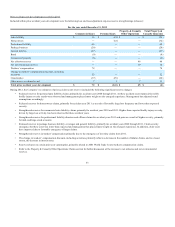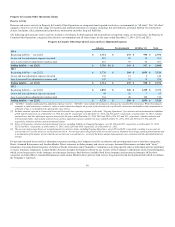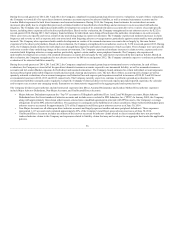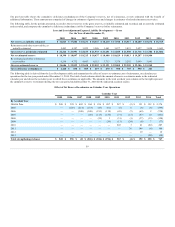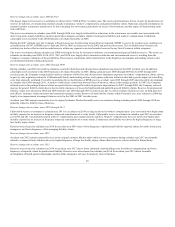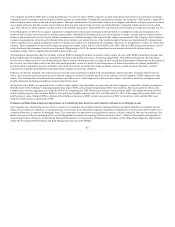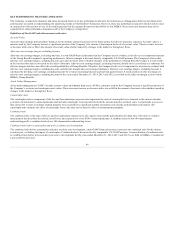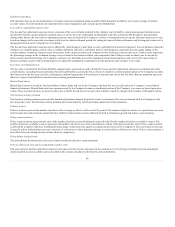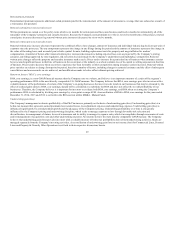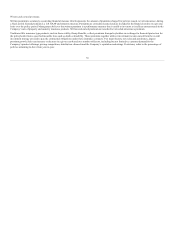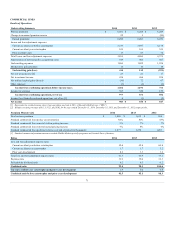The Hartford 2014 Annual Report Download - page 63
Download and view the complete annual report
Please find page 63 of the 2014 The Hartford annual report below. You can navigate through the pages in the report by either clicking on the pages listed below, or by using the keyword search tool below to find specific information within the annual report.
Living Benefits Required to be Fair Valued (in Other Policyholder Funds and Benefits Payable
Fair values for GMWBs classified as embedded derivatives are calculated using the income approach based upon internally developed models, because
active and observable markets do not exist for those items. The fair value of these GMWBs and the related reinsurance and customized freestanding
derivatives are calculated as an aggregation of the following components: Best Estimate Claim Payments; Credit Standing Adjustment; and Margins. The
resulting aggregation is reconciled or calibrated, if necessary, to market information that is, or may be, available to the Company, but may not be observable
by other market participants, including reinsurance discussions and transactions. The Company believes the aggregation of these components, as necessary
and as reconciled or calibrated to the market information available to the Company, results in an amount that the Company would be required to transfer or
receive, for an asset, to or from market participants in an active liquid market, if one existed, for those market participants to assume the risks associated with
the guaranteed minimum benefits and the related reinsurance and customized derivatives. The fair value is likely to materially diverge from the ultimate
settlement of the liability as the Company believes settlement will be based on our best estimate assumptions rather than those best estimate assumptions
plus risk margins. In the absence of any transfer of the guaranteed benefit liability to a third party, the release of risk margins is likely to be reflected as
realized gains in future periods’ net income. Oversight of the Company's valuation policies and processes for product and GMWB reinsurance derivatives is
performed by a multidisciplinary group comprised of finance, actuarial and risk management professionals. This multidisciplinary group reviews and
approves changes and enhancements to the Company's valuation model as well as associated controls
For further discussion on the impact of fair value changes from living benefits see Note 5 - Fair Value Measurements of Notes to Consolidated Financial
Statements, and for a discussion on the sensitivities of certain living benefits due to capital market factors see Variable Product Guarantee Risks and Risk
Management section of the MD&A.
Goodwill Impairment
Goodwill balances are reviewed for impairment at least annually or more frequently if events occur or circumstances change that would indicate that a
triggering event for a potential impairment has occurred. The goodwill impairment test follows a two-step process. In the first step, the fair value of a
reporting unit is compared to its carrying value. If the carrying value of a reporting unit exceeds its fair value, the second step of the impairment test is
performed for purposes of measuring the impairment. In the second step, the fair value of the reporting unit is allocated to all of the assets and liabilities of the
reporting unit to determine an implied goodwill value. If the carrying amount of the reporting unit’s goodwill exceeds the implied goodwill value, an
impairment loss is recognized in an amount equal to that excess.
Management’s determination of the fair value of each reporting unit incorporates multiple inputs into discounted cash flow calculations including
assumptions that market participants would make in valuing the reporting unit. Assumptions include levels of economic capital, future business growth,
earnings projections, assets under management for Mutual Funds, and the weighted average cost of capital used for purposes of discounting. Decreases in the
amount of legal entity capital held or economic capital allocated to a reporting unit, decreases in business growth, decreases in earnings projections and
increases in the weighted average cost of capital will all cause a reporting unit’s fair value to decrease.
A reporting unit is defined as an operating segment or one level below an operating segment. The Company’s reporting units, for which goodwill has been
allocated, are equivalent to the Company’s operating segments of Group Benefits, Personal Lines and Mutual Funds.
The carrying value of goodwill is $498 as of December 31, 2014 and is comprised of $138 for Group Benefits, $119 for Personal Lines, and $241 for Mutual
Funds.
The annual goodwill assessment for the Group Benefits, Personal Lines and Mutual Funds reporting units was completed during the fourth quarter of 2014,
which resulted in no write-downs of goodwill for the year ended December 31, 2014. The reporting units passed the first step of the annual impairment test
with a significant margin with the exception of the Group Benefits reporting unit. Group Benefits passed the first step of its annual impairment test with less
than a 10% margin. The fair value of the Group Benefits reporting unit is based on discounted cash flows using earnings projections on in force business and
future business growth. There could be a positive or negative impact on the results of step one in future periods if assumptions change about the level of
economic capital, future business growth, earnings projections or the weighted average cost of capital. Please see Note 9 - Goodwill for information regarding
the 2013 and 2012 impairment tests.
63


